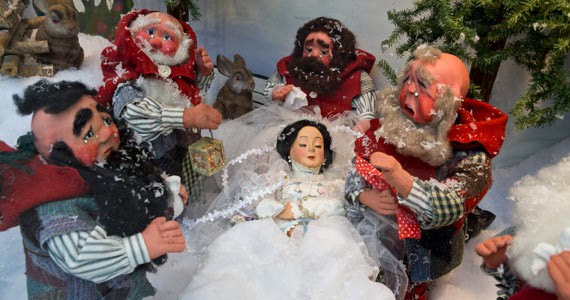For some, ringing in the holidays in Halifax is marked by the first sighting of the forest wake in the Mills window---a tradition that first popped up in the late 1940s.
Snow White lies in a woodland tomb as her seven pals weep diamond tears and robotically dry their eyes. The dwarfs are rotund and ruddy, perhaps from excessive burgundy and strudel. Maybe they forgot to check her pulse before having her enshrined, because, in dramatic irony, onlookers can see her mechanical heart is still beating strong.
All she needs is one of those patented coma-kicking kisses from Prince Charming, who's trumpeting his arrival off in the distance.
"When people see the Snow White window, it warms their heart---it's the signal in the city that Christmas is coming," says Audrey Parker, Mills' general manager. "For many many years, a lot of families would make their way to Mills just to see the window. It was an important part of Christmas in Halifax. A major tradition."
One of the department store's original owners, Hugh Mills, stumbled on the dolls while travelling through the Black Forest in Germany shortly after World War II. He and his wife, Jean, brought them back for the store's window.
The scene made its annual appearance for a few years during the early 1950, then went into storage. In 1973 Hugh Mills' niece, Jane MacLellan, brought them out again. For many years the tradition was maintained by MacLellan. This year Parker has taken up the post.
"The dolls themselves were terribly damaged in a fire that happened years ago," explains Parker. But MacLellan was determined to get them refurbished so she found Joan Doherty, a local doll maker. "Joan made new clothing for them, she repainted their faces and did beautiful detail work to bring them alive again.
"You don't necessarily think of Snow White and the Seven Dwarfs as a Christmas scene, but because they were brought out at Christmas they've come to signify the season," says Parker. "They signify life too. We all go through our ups and downs. If they were brand-new items in store, no one would probably even notice them, but they look traditional and they have scars like the rest of us."
The slightly macabre, dramatic spectacle offers a throwback to when window dressing was an art form. Both Andy Warhol and Salvador Dali had stints practising the trade, where showmanship often trumped the products. The twist in the Mills window is there are no objects of desire to lure you into the store---it's just pure theatrics.
















